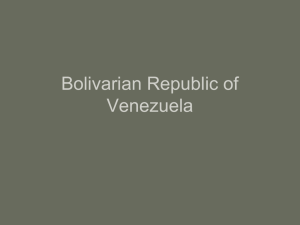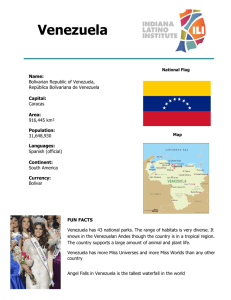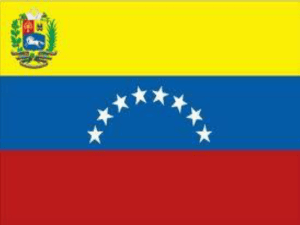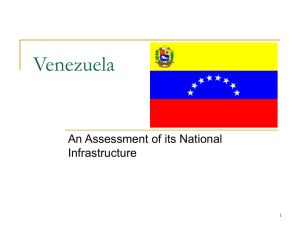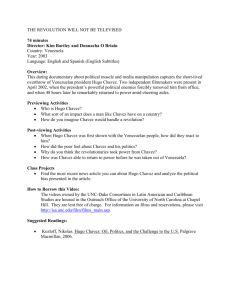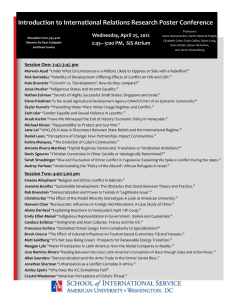Document 13727072
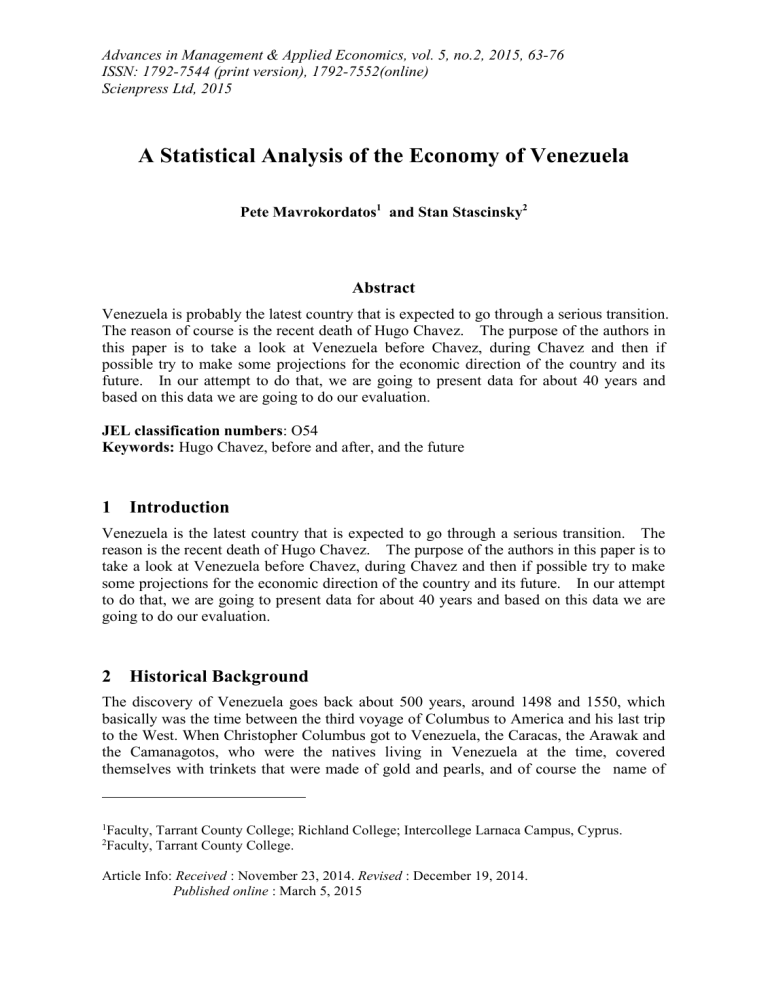
Advances in Management & Applied Economics, vol. 5, no.2, 2015, 63-76
ISSN: 1792-7544 (print version), 1792-7552(online)
Scienpress Ltd, 2015
A Statistical Analysis of the Economy of Venezuela
Pete Mavrokordatos
1
and Stan Stascinsky
2
Abstract
Venezuela is probably the latest country that is expected to go through a serious transition.
The reason of course is the recent death of Hugo Chavez. The purpose of the authors in this paper is to take a look at Venezuela before Chavez, during Chavez and then if possible try to make some projections for the economic direction of the country and its future. In our attempt to do that, we are going to present data for about 40 years and based on this data we are going to do our evaluation.
JEL classification numbers : O54
Keywords: Hugo Chavez, before and after, and the future
1 Introduction
Venezuela is the latest country that is expected to go through a serious transition. The reason is the recent death of Hugo Chavez. The purpose of the authors in this paper is to take a look at Venezuela before Chavez, during Chavez and then if possible try to make some projections for the economic direction of the country and its future. In our attempt to do that, we are going to present data for about 40 years and based on this data we are going to do our evaluation.
2 Historical Background
The discovery of Venezuela goes back about 500 years, around 1498 and 1550, which basically was the time between the third voyage of Columbus to America and his last trip to the West. When Christopher Columbus got to Venezuela, the Caracas, the Arawak and the Camanagotos, who were the natives living in Venezuela at the time, covered themselves with trinkets that were made of gold and pearls, and of course the name of
1 Faculty, Tarrant County College; Richland College; Intercollege Larnaca Campus, Cyprus.
2 Faculty, Tarrant County College.
Article Info: Received : November 23, 2014. Revised : December 19, 2014.
Published online : March 5, 2015
64 Pete Mavrokordatos and Stan Stascinsky the newly discovered land was not Venezuela. The name Venezuela was given to it by a Spanish conqueror by the name Alonso de Ojeda who called it Little Venice, due to the similarities between the natives’houses that were on stilts in a lake, and those in Venice,
Italy.
Venezuela went through a lot of changes during the first years of its history, but a major change took place during 1795. At that time there was a revolution against Spanish control, but was not very successful. A successful revolution took place around 1810, after Napoleon took control of Spain.
The leader of this revolution was Francisco de Miranda, and by 1811 a complete independence was declared in Venezuela. A few years later, Venezuela with a number of other territories joined the Federal Republic of Colombia, but a few years later, around
1830, Venezuela along with New Granada came out, and that was the collapse of the Gran
Colombia. Since then, up until 1959 the country was run by military people, who for the most part promoted the oil industry and encouraged some social reforms.
After 1959 the country was run my democratic governments, until 1999 when Hugo
Chavez became president until 2013, the year of his death. Chavez graduated from the
Venezuelan Academy of Military Sciences, and became the president of Venezuela in
1999. His presidency had its ups and downs, and the worst was the straining relations with the United States because he as selling oil to Cuba, and he did nothing to stop drug trafficking in Columbia. Chavez during his presidency created a lot of controversies, but the worst one was when he tried to put the oil industry under complete government control, and this pushed the military to remove him from power temporarily during 2002.
For this removal, Chavez was blaming the U.S. but he came back and run Venezuela until his death in 2013.
As mentioned above Venezuela has a history of about 500 years as it is known today, so below the authors will include a timeline highlighting some of the most important events of Venezuela’s history:
Timeline
Again this is not a complete timeline of Venezuela’s history, but only some of the most important events.
1498 Christopher Columbus sailed along Venezuela’s eastern coast
1498 Alonso de Ojeda names the country’s north coast “Venezuela” or “Little Venice”
1550 African slaves shipped to Venezuela to work on plantations
1521 – 22 Spanish colonization begins
1811 Venezuela declares independence from Spain
1821 Gran Colombia (Venezuela, Colombia, Panama and Ecuador) wins independence from Spain
1830 Venezuela separates from Gran Colombia and Caracas becomes the Capital
1908 – 35 Venezuela becomes one of the world’s largest oil exporters
1947 Venezuela’s first democratically elected leader, Romulo Gallegos overthrown by the military
1964 Raul Leoni becomes president
1983 Major government spending cuts due to world oil pries falling
1989 Loans from the IMF are requested by president Carlos Andres Perez
1992 Failed coup by Hugo Chavez, who is also jailed
1994 Chavez out of jail and forms a political party
A Statistical Analysis of the Economy of Venezuela 65
1998 Hugo Chavez elected president
1999 Chavez promises to reduce poverty and corruption
2004 Voters defeat an effort to recall Chavez
2006 Chavez wins re – election for a new 6 year term
2005 Chavez takes control over four heavy oil products in the Orinoco belt
2010
The opposition to Chavez gains a lot of power, but still Chavez’s party remains a majority and in power.
2011 Chavez undergoes cancer surgery in Cuba
2012 Chavez re – elected regardless his illness
2013 Chaves dies of cancer
2014 Presidential elections see Chavez’s chosen successor, Nicolas Maduro elected.
3 Current Literature
In this section the authors will present and discuss a lot of data, (for about 40 years) for
Venezuela, and that will basically give us a good idea about the economy over the years.
The authors will present the most recent economic data in order to evaluate the current economic situation. The majority of this section though will concentrate on a few years before Hugo Chavez, and a number of years during Hugo Chavez’s rule.
It is not a big secret that the relations between Venezuela and the United States are not the best. In fact Hugo Chavez was very outspoken and let his feelings about the U.S. known in several occasions during his presidency. The reason that these relations did not get any worse, is oil. The need of U.S. of Venezuelan oil and the need of Venezuela for the
American dollar. In fact, during 2010 oil exports to the U.S. were $26 billions.
These relations are expected to gradually improve now that Chavez is gone and the people of Venezuela realize that they have a lot to benefit from the U.S.
As was mentioned above, Venezuela has an abundance of oil, and this contributed to a strong economy during the later years of the 20 th century. This growth encouraged the government to initiate a lot of social programs and food subsidies. This though could not go on for ever, and during the late 198’s, as a result of the worldwide oil prices drop, the government had to implement several liberal economic policies in order to fight the price drops. These policies were not successful the prices continued to rise in relation to
Venezuela’s per capita income.
As a result of this economic turmoil, we see the rise of socialism and Hugo Chavez in the late 1990’s. When Hugo Chavez took over, he increased social spending, but the
Venezuelan economy continued to suffer due to high levels of corruption and shortages of necessities.
The two figures below summarize the situation in Venezuela for both years before and during Hugo Chavez’s rule.
66 Pete Mavrokordatos and Stan Stascinsky
Figure 1: Economic Information
Figure 1 presents more than just economic information. The first data shows children enrolled in education, and as can be seen there is a steady improvement since 1999, which was the year that Chavez took over. The second set of data shows households below the poverty line, and really this is the only one that is worse since 1999. Another one that showed improvement is the life expectancy. In 1999 life expectancy was around 72 and by 2005 it jumped to almost 74.
The last set of data shows the GDP per capita. This one actually declined for a few years after 1999, but as the next figure shows, it more than doubled by 2011.
A Statistical Analysis of the Economy of Venezuela 67
Figure 2: Economic Indicators for India
Figure 2 shows several key economic indicators for Venezuela. The date here starts at
1999, the year that Chavez took over, and goes all the way to 2011 and 2012. As can be seen some of them showed drastic improvement.
4 Statistical Analysis
In this section the authors will present the economic situation in Venezuela in numbers.
For that purpose the table that follows on the next page includes a number of economic indicators, such as the Gross Domestic Product, Venezuela’s population, the Growth Rate,
Venezuela’s trade, both exports and imports, and unemployment, and all this data will be shown for about 40 years. The data will also be shown in graphs for comparison and evaluation purposes.
68 Pete Mavrokordatos and Stan Stascinsky
1984
1985
1986
1987
1988
1989
1990
1991
1976
1977
1978
1979
1980
1981
1982
1983
1992
1993
1994
1995
1970
1971
1972
1973
1974
1975
Table 1: Venezuela Data 1970 – 2012
GDP 2005 POP.
GR. R.
M 2005 X 2005
U.S. B $
73.71
74.8
75.76
81.15
82.83
85.23
MILLIONS %
10.7
11.1
11.5
11.9
12.3
12.7
91.61
91.79
97.77
101.27
107.16
97.98
104.32
114.47
91.81
97.57
99.86
100.63
96.18
95.83
93.84
90.31
131.4
121.74
118.88
123.57
1996
1997
123.33
131.19
22.6
23
1998 131.57
BEGINNING OF THE CHAVEZ YEARS
23.5
1999
2000
2001
2002
123.72
128.28
132.63
120.89
23.9
24.4
24.9
25.3
2003
2004
2005
2006
2007
2008
2009
2010
111.51
131.9
145.51
159.88
173.87
183.05
177.19
174.55
2011
2012
END OF CHAVEZ YEARS
181.84
192.07
25.8
26.3
26.7
27.2
27.7
28.1
28.6
29
29.5
29.9
16.9
17.3
17.8
18.3
18.8
19.3
19.7
20.2
13.2
13.7
14.2
14.6
15.9
15.5
15.9
16.4
20.7
21.2
21.6
22.1
39.8
38.1
42.8
42.3
43.9
46.5
53.1
55.4
51.4
48.2
45.8
49.5
41.4
39
35.4
34.3
54.2
60.8
65.7
69.8
75.2
60.4
62.6
11.4
8
7.6
11.4
9.5
9.2
9.1
9.9
10.6
13.6
13.3
10.2
10
11.3
13.1
6.2
14.3
13.4
10.9
13.5
12
18.3
20.3
1.44
0.19
6.51
3.58
5.82
-8.6
6.47
9.73
7.73
6.27
2.35
0.76
-4.4
-0.4
-2.1
-3.8
6.06
0.28
-2.3
3.95
-0.2
6.37
0.29
8.75
5.28
-3.2
-1.5
4.18
5.63
-6
3.69
3.39
-8.9
-7.8
18.3
10.3
9.87
7.71
1.48
1.28
7.11
2.07
2.9
U.S. B $
6.1
7.9
53.4
54.1
43.5
42.3
48.8
60.7
18.4
20.7
23.6
17.7
13.9
32
29.8
40.1
U.S. B $
64.9
51.9
51.7
51.2
44.2
38.5
40.3
40.9
55.7
58.9
56.8
54.6
48.9
55.6
57.7
55.9
Xn 2005
U.S. B $
58.8
44
-1.7
-2.9
0.7
-3.8
-8.5
-19.8
37.3
38.2
33.2
36.9
35
23.6
27.9
15.8
UNEMP.
%
7.5
6.9
7.8
8.6
8.3
8.1
14.5
13.2
12.8
16.2
16.8
15
11.4
9.3
30.3
28.9
33.7
32.4
32.5
38.5
45.5
44
40.8
34.6
32.5
39.3
31.4
27.7
22.3
28.1
39.9
47.4
54.8
56.3
63.2
42.1
42.3
7.3
9.7
10.3
9.5
7.7
6.7
8.6
10.2
5.9
7
8.1
11.5
12.9
13.2
10.9
9.1
12.4
10.6
11
SOURCE: The World Databank, http://databank.worldbank.org
The figure that follows, Figure 3, shows Venezuela’s GDP and its population, between
1970 and 2012.
A Statistical Analysis of the Economy of Venezuela 69
Figure 3: Venezuela GDP and Population 1970-2012
What can be seen here is that even though population had a steady growth during these years, the GDP has grown a much faster rate, which means that the population did not have an impact on the GDP. Figure 4 on the following page shows Venezuela’s population and growth rate for the years 1970 – 2012.
Figure 4: Venezuela Population and Growth Rate 1970-2012
70 Pete Mavrokordatos and Stan Stascinsky
This graph shows a steady growth of population, but the growth rate does not seem to respond to that, even though there was a big jump after Chavez took over, around 2004, but it did not last very long.
Figure 5 below shows Venezuela’s exports (X), imports (M), and net exports (Xn).
Figure 5: Venezuela Exports (X), Imports (M), and Net Exports (Xn)
It can be seen that Venezuela had positive Xn for years, obviously because of oil exports, but the net exports have been declining after Chavez took over, and finally they became negative during the last six or seven years. Our research has not found any economic reasons to explain this turn around of exports. The only possible thing that can explain this is that countries started boycotting Venezuela’s oil due to Chavez.
5 Conclusion
In this last section, the authors will try to derive some conclusions from the data presented.
Our research basically did not find a negative impact on the economy after Chavez took over in 1999. In fact Figures 1 and 2 for the most part are showing improvement in most of the areas presented. Out of all the data presented only 2 are worse after than before.
The people under the poverty line and inflation which reached 31.6% by 2012, but it was rising for a number of years earlier.
Chavez died in 2013, and the world as a whole expected and still expects that things will change in Venezuela both politically and economically. To this date though nothing has drastically changed, the success of the new president, Nicolas Maduro, who was Chavez’s choice, is questionable and everybody is waiting to see which direction he will take
Venezuela. In conclusion the authors would like to say that this is not a complete paper, but only the beginning of a topic that could last for years. To that end, any suggestions or recommendations that can improve and take this paper a step further will be appreciated.
A Statistical Analysis of the Economy of Venezuela 71
References
[1] Moron, G. History of Venezuela .(1963). Roy Publishers, Inc. New York
[2] Hugo Rafael Chávez Frías . (2014). Retrieved January 2, 2014 from http://www.biography.com/people/hugo-chávez-193225.
[3] Profile: Hugo Chavez . (2013, February 13). Retrieved January 22, 2014 from http://www.bbc.com/news/world-latin-america-10086210
[4] South America::Venezuela . (n.d.).Retrieved February 6, 2014 from https://www.cia.gov/library/publications/the-world-factbook/geos/ve.html
[5]
Timeline: Venezuela’s tumultuous history
. (n.d.). Retrieved January 23, 2014 from http://www.aljazeera.com/indepth/features/2012/09/201292121430533264.html
[6] Venezuela. (n.d.). Retrieved March 16, 2014 from www.cia.gov/
[7] Venezuela: Country Snapshot . (n.d.). Retrieved January 21, 2014 from http://www.globalroadwarrior.com/contentinfo.asp?cid=159&nid=65&next_nid=66
[8] Venezuela: History . (2012). Retrieved January 22, 2014 from http://www.infoplease.com/encyclopedia/world/venezuela.html
[9] Venezuela Profile: Facts.
(2013). Retrieved January 23, 2014 from http://www.bbc.com/news/world-latin-america-19649649
[10] Venezuela time line chronological timetable of events . (n.d.). Retrieved March
12,2014 from http://www.worldatlas.com/webimage/countrys/samerica/venezuela/vetimeln.htm
[11] Wilson, H.W. The Future of U.S. Economic Relations: Mexico, Cuba, and
Venezuela . (2013). The Reference Shelf, Volume 85, Number 3, EBSCO Publishing,
Inc., Ipswich, Mass.
72 Pete Mavrokordatos and Stan Stascinsky
Appendix
In this section of the paper, the authors ran several regressions using the data presented earlier in the paper. The regressions are an attempt to measure aspects of Venezuela’s economy. The authors ran three scenarios for each model: one using the entirety of the data presented, one using the data before Hugo Chavez’s rule and one during Chavez’s rule. The findings are presented below using the entirety, before and during approach.
Model #1
The first model uses population as independent and unemployment as dependent. The hypothesis is that unemployment does not depend on population. The value of the R 2 in each scenario is 0.01, 0.11 and 0.83 respectively. The numbers indicate a small amount of Venezuela’s unemployment overall and before Hugo Chavez’s rule is explained by the population, while a rather large percentage, 83%, is explained during Chavez’s rule.
The P value for this hypothesis test is 0.573, 0.079 and 5.85x10
-6 . Since this value is less than 0.05 only during Chavez’s rule, the hypothesis is rejected during that time but accepted overall and before Chavez’s rule.
These results are shown on the next page in Figures 1a, 1b and 1c.
Unemployment vs. Population-all
20
10
0
10
Y
Predicted Y
15 20
Population
25 30
Figure 1a
Unemployment vs. Population-before
20
10
0
10 25
Y
Predicted Y
15
Population
20
Figure 1b
A Statistical Analysis of the Economy of Venezuela 73
Unemployment vs. Population-during
200
150
100
50
0
20 25 30 35
Y
Predicted Y
Population
Figure 1c
Model #2
The second model uses net trade as independent and gdp as dependent. The hypothesis is that gdp does not depend on net trade. The value of the R 2 in each scenario is 0.524,
0.197 and 0.933 respectively. The numbers indicate a significant amount of Venezuela’s gdp is explained by Venezuela’s net trade regardless of the time period considered in this paper. The P value for this hypothesis test is 1.88x10
-7 , 0.026 and 2.14x10
-8 . Since this value is less than 0.05 at each of the three time periods considered in this paper, the hypothesis is rejected overall, before Chavez’s rule and during Chavez’s rule.
These results are shown below in Figures 2a, 2b and 2c.
GDP vs. Net Trade-all
-20
200
150
100
50
0
0 80
Y
Predicted Y
20 40
Net Trade
Figure 2a
60
74 Pete Mavrokordatos and Stan Stascinsky
GDP vs Net Trade-before
150
100
50
0
20
Y
Predicted Y
30 40 50
Net Trade
Figure 2b
60 70
GDP vs. Net Trade-during
200
100
0
0
Y
Predicted Y
-20 -10 10
Net Trade
20 30 40
Figure 2c
Model #3
The third model uses net trade as independent and population as dependent. The hypothesis is that population does not depend on net trade. The value of the R 2 in each scenario is 0.324, 0.144 and 0.914 respectively. The numbers indicate a small amount of
Venezuela’s population overall and before Hugo Chavez’s rule is explained by
Venezuela’s net trade, while a rather large percentage, 91%, is explained during Chavez’s rule. The P value for this hypothesis test is 0.0002, 0.061 and 9.79x10
-8 .
Since this value is less than 0.05 overall and during Chavez’s rule, the hypothesis is rejected during that time but accepted (barely) before Chavez’s rule.
These results are shown below in Figures 3a, 3b and 3c.
A Statistical Analysis of the Economy of Venezuela 75
Population vs. Net Trade-all
-20
30
20
10
0
0 20 40
Net Trade
60 80
Figure 3a
Population vs. Net Trade-before
Y
Predicted Y
20
10
0
0
Y
Predicted Y
20
Net Trade
40
Figure 3b
60
Population vs. Net Trade-during
30
20
10
0
Y
Predicted Y
-20 0 20 40
Net Trade
Figure 3c
Model #4
The final model uses imports as independent and unemployment as dependent. The hypothesis is that unemployment does not depend on imports. The value of the R 2 in each scenario is 0.061, 0.13 and 0.842 respectively. The numbers indicate a small amount of Venezuela’s unemployment overall and before Hugo Chavez’s rule is explained by imports, while a rather large percentage, 84%, is explained during Chavez’s
76 Pete Mavrokordatos and Stan Stascinsky rule. The P value for this hypothesis test is 0.165, 0.648 and 3.83x10
-6 . Since this value is less than 0.05 only during Chavez’s rule, the hypothesis is rejected during that time but accepted overall and before Chavez’s rule.
These results are shown on the next page in Figures 4a, 4b and 4c.
Unemployment vs. Imports-all
20
10
0
0
Y
Predicted Y
20 40
Imports
60
Figure 4a
Unemployment vs. Imports-before
80
15
10
5
0
0
Y
Predicted Y
5 10
Imports
15 20
Figure 4b
Unemployment vs. Imports-during
25
20
10
0
0 10 20 60 70
Y
Predicted Y
30 40
Imports
Figure 4c
50
